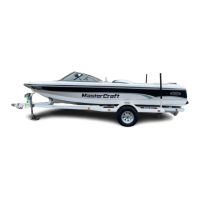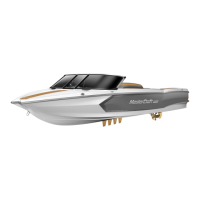2021 OWNERS MANUAL / 418
According to DOT and OEM requirements, brand new DOT 3
brake fluid must have a dry (no moisture) boiling point of at least
401
o
F/205
o
C, and a wet (moisture saturated) boiling point of no less
than 284
o
F/140
o
C. (Most far exceed these requirements, fresh out of
the bottle.) Older brake fluid (about 18 months) with even three per-
cent (3%) moisture content lowers the boiling point to 293
o
F/145
o
C,
which is dangerously close to the minimum standard requirements.
Water contamination increases the danger of brake failure because
vapor pockets can form if the fluid gets too hot. Vapor displaces flu-
id and is compressible, so when the brakes are applied, the actuator
may completely compress without applying the brakes.
In addition, water laden brake fluid promotes corrosion and pitting
in caliper pistons and bores, wheel cylinders, master cylinders, steel
brake lines and reverse solenoids.
Consumers must use only DOT 3—preferred—or DOT 4 brake fluid. DO
NOT USE DOT 5 BRAKE FLUID. DOT 5 FLUID WILL DAMAGE THE SEALS
IN THE ACTUATOR AND CALIPERS, CAUSING FAILURE OF BRAKES
THAT COULD LEAD TO INJURY OR DEATH. Any other type may not pro-
vide sucient chemistry to protect against overheating. Brake fluid
should be completely replaced during annual maintenance (at least
once every 12 months or more often if the system has shown evidence
of brake fluid loss). Brake fluid types should never be mixed. Failure
to provide required maintenance can cause brake failure, leading to
incidents that result in serious injury or even death.
Review the tow vehicle manufacturer’s recommendations and
instructions for towing.
If the brakes are hot then before launching your boat, it is a good
idea to allow the brakes to cool before submerging them. The sud-
den change in temperature when submerging very hot calipers and
rotors stresses all the related parts and could cause damage.
If you are unable to back up, check the electronically operated
back-up valve on the actuator, which is connected to the tow vehicle
back up lights. When energized, the valve opens and prevents
pressure build up in the system. When it is energized by shifting the
tow vehicle into reverse, you should hear a noticeable “click” sound.
If you don’t, check that the electrical connection between the tow
vehicle and the trailer is secure.
When parking the trailer, be sure the actuator is fully extended. This
position relieves pressure on the brakes. Corrosion sometimes
causes actuators to freeze in the compressed position. This causes
the brakes to drag and overheat during subsequent outings.
Recommended Brake Fluid
After only a year of use, used brake fluid in the typical marine trailer
may contain as much as two percent (2%) water. Over time, the
percentage will continue to grow and may reach as much as eight
percent (8%). As the concentration of moisture increases, a sharp
drop in the fluid’s boiling point temperature results. As little as one
percent (1%) moisture can lower the boiling point to 369
o
F/187
o
C.
2021MCOwnerManualFINAL.indd 418 8/26/20 1:55 PM

